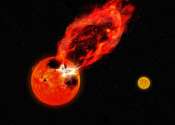New tool could predict large solar storms more than 24 hours in advance
Large magnetic storms from the Sun, which affect technologies such as GPS and utility grids, could soon be predicted more than 24 hours in advance.

Large magnetic storms from the Sun, which affect technologies such as GPS and utility grids, could soon be predicted more than 24 hours in advance.
Space Exploration
Jun 9, 2015
0
66

Earth experienced a geomagnetic storm on June 22, 2015 due to the arrival of an Earth-directed coronal mass ejection, or CME, from June 20.
Space Exploration
Jun 25, 2015
0
40

A team of Japanese astronomers used simultaneous ground-based and space-based observations to capture a more complete picture of a superflare on a star. The observed flare started with a very massive, high-velocity prominence ...
Astronomy
Apr 28, 2023
0
137

(Phys.org)—Overnight on October 4-5, 2012, a mass of energetic particles from the atmosphere of the Sun were flung out into space, a phenomenon known as a coronal mass ejection. Three days later, the storm from the Sun ...
Space Exploration
Oct 10, 2012
5
0

Europe launched its first space weather coordination centre Wednesday to raise the alarm for possible satellite-sizzling solar storms that also threaten astronauts in orbit, plane passengers and electricity grids on Earth.
Space Exploration
Apr 3, 2013
5
0

The sun erupted over the weekend, flinging electromagnetic radiation towards Earth, even illuminating skies with spectacular aurora borealis. For the first time, ESA's unlikely space weather duo of SMOS and Swarm tracked ...
Astronomy
Mar 26, 2024
0
42

Dust particles smaller than about a wavelength of light are abundant in our solar system, created by collisions between asteroids and from the evaporation of comets. As they scatter sunlight, these particles produce the zodiacal ...
Astronomy
Mar 9, 2015
4
53

(Phys.org)—On Nov. 21, 2012, at 11:24 a.m. EST, the sun erupted with an Earth-directed coronal mass ejection or CME. Experimental NASA research models, based on observations from the Solar Terrestrial Relations Observatory ...
Space Exploration
Nov 23, 2012
0
0

A NASA scientist is launching a one-to-two-year pilot project this summer that takes advantage of U.S. high-voltage power transmission lines to measure a phenomenon that has caused widespread power outages in the past.
Space Exploration
Apr 23, 2014
1
0

Hundreds of millions of people will witness next week's total solar eclipse across North America, and solar physicists from around the globe are flocking to join them. Eclipses offer a brief glimpse of the sun's ghostly surrounding ...
Astronomy
Apr 4, 2024
0
26